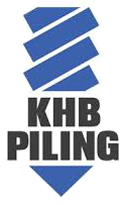Piling is a critical element in the construction industry, providing robust foundations for structures in various ground conditions. As a core service offered by KHB Piling, London’s premier piling contractor, we recognize the importance of understanding different piling techniques to ensure the success of your construction project. In this blog post, we’ll delve into the five most common types of piling and their applications to help you make informed decisions when embarking on your next project.
- Driven Piles:
Driven piles are a widely-used piling method involving the driving of pre-fabricated piles into the ground using a piling hammer. These piles can be made from steel, timber, or precast concrete. Driven piles suit various soil conditions and offer a cost-effective solution for projects requiring rapid installation.
- Bored Piles:
Bored piles, also known as drilled shafts, involve drilling a hole into the ground and filling it with concrete to create a sturdy foundation. This method is ideal for situations where minimal noise and vibrations are required, such as close to existing structures or in urban areas. Bored piles can accommodate larger loads and are well-suited for deep foundation projects.
- CFA (Continuous Flight Auger) Piles:
CFA piles combine the benefits of driven and bored piles, offering a low-noise, vibration-free solution with the capacity to support heavy loads. This piling method uses a continuous flight auger to drill into the ground while injecting concrete through the hollow stem of the auger. CFA piles are often used in challenging ground conditions and urban environments.
- Mini Piles:
Mini piles, also known as micro piles, are small-diameter piles that can be installed in limited access or low-headroom areas. They are commonly used for underpinning, retrofitting, or strengthening existing structures. Mini piles can be made from steel or reinforced with grout, making them a versatile option for various soil conditions.
- Screw Piles:
Screw piles, also known as helical piles, consist of steel shafts with helical plates that are screwed into the ground. They can be quickly installed with minimal noise and vibration, making them suitable for environmentally-sensitive areas. Screw piles are ideal for projects with tight deadlines or sites where traditional piling methods may not be feasible.
Conclusion:
Understanding the various types of piling is essential for selecting the most appropriate method for your construction project. Each technique offers unique advantages and limitations, depending on soil conditions, load requirements, and project constraints. As one of the top piling contractors in London, KHB Piling is equipped with the expertise and experience to help you make the best choice for your foundation needs. Contact us today to discuss your project and discover how our piling services can ensure the success of your construction endeavours.


